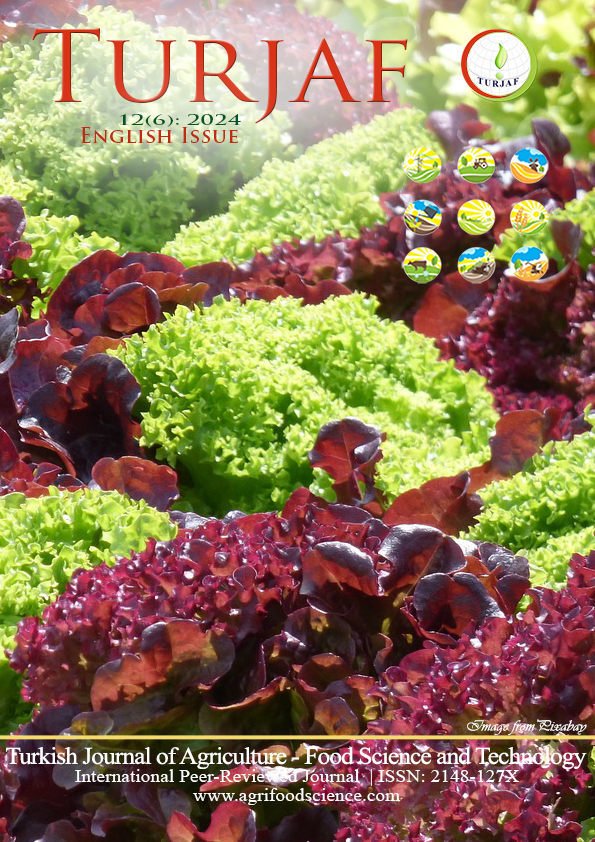Determination of Thermal Efficiency and Fuel Consumption Rate of a Pressure Cooker Fueled with Blends of Waste Vegetable Oil and Kerosene
DOI:
https://doi.org/10.24925/turjaf.v12i6.1033-1038.6319Anahtar Kelimeler:
Pressure cooker- thermal efficiency- kerosene- fuel atomization- household energyÖzet
In Nigeria, before the removal of subsidy on kerosene in 2016, the product was accessible to low-income individuals and is intended to be used as a fuel for cooking, lighting, or heating. Recently, kerosene is rapidly vanishing from rural families and it is becoming inaccessible due to its ever-rising cost. Therefore, to ease the hardship of low-income individuals to have access to high thermal efficiency cookers with affordable fuel, a study was carried out to determine the thermal efficiency and fuel consumption rate of a pressure cooker fueled with a blend of waste vegetable oil and kerosene. Based on this, a low-cost pressure cooker was developed with locally available materials to aid the atomization of fuel during cooking. Along with this, vegetable oil was blended with kerosene to enhance the quantity of kerosene used to fuel the pressure cooker. This cooker fueled with blends of vegetable oil and kerosene was analyzed for its thermal efficiency and fuel consumption rate and was also compared to the conventional kerosene stove. The result shows that the constructed pressure cooker has a thermal efficiency of 52% which is 20% more than the conventional kerosene stove but the developed pressure cooker consumes more fuel (48.62 ml) than the conventional kerosene wick stove (33.78 ml). Though the pressure cooker consumes more fuel, the thermal efficiency per time with respect to the fuel consumed is much better than conventional kerosene stoves which makes the developed cooker cheaper and more affordable both to low-income earners and for rural dwellers.
Referanslar
Bayindir, H. (2007). Perfomance evaluation of a diesel engine fueled with cotton oil-kerosene blends.Technological Applied Sciences, 2(1):30-38.
Desalu, O. O., Ololade, O. O., Ebenezer, K. A., Kolawole, T. F., and Ayodele, I. O. (2012). “A community survey of the pattern and determinants of household sources of energy for cooking in rural and urban southwestern, Nigeria”. The Pan African Medical Journal - ISSN 1937-8688
Edward, O. O., and Raji, T. A. (2021). “Determinants of Alternative Sources of Cooking Energy among Households in Ekiti State, Nigeria” The International Journal of Humanities & Social Studies. 9(3).
Fatai, O. A., David, O. O., Muyideen, B. B., and Dambvo, L. (2018). “Development, Evaluation, and Soot Formation Characteristics of a Low-cost Pressurised Kerosene Stove” The Journal of the Association of Professional Engineers of Trinidad and Tobago. 46(1):13-21.
HTML2 (2024) http://www.britannica.come/science/pascals-principle accessed on the 29th of March, 2024.
HTML1 (2024). http://www.chemistrylearner.com/laws-of-thermodynamics/first-laws-of-thermodynamics accessed on the 29th of March, 2024.
HTML3 (2024)https://www.byjus.com/physics/bernoullis-principle/#:~:text=Bernoulli’s%20principle%20formulated%20by%20Daniel,form%20in%20the%20year%201752) accessed on the 29th of March, 2024.
Kaushik, L.K. and Muthukumar, P. (2020). Thermal and economic performance assessments of waste cooking oil/kerosene blend operated pressure cook-stove with porous radiant burner. Journal of Energy. 2020.118102.
Moh, K. D. (2010) “The Design and Construction of a Portable Kerosene Pressure-Cooker”. An International Multi-Disciplinary Journal, Ethiopia. 4 (2):15-29
Mukun, Y. P., Suraj, P., Kunal, D., Ganesh, R., Kunal, W., and Ashish, P. (2017). “Experimental Investigation on Pressure Stove with Different Blends of Fuel” IOSR Journal of Mechanical and Civil Engineering (IOSR-JMCE) X. 14(4): 61-68.
Ogundahunsi, O. E., Ogunsina, B. S., and Aransiola, E. F. (2022a). Kariya Biodiesel Process Optimization Using Kariya Pod-husks Bio-catalyst. Journal of Energy Research and Reviews. 11(4): 33-47.
Ogundahunsi, O. E., Ogunsina, B. S., and Aransiola, E. F. (2022b). Kariya Pod-Husks: A Novel Biocatalyst in Biodiesel Production. Journal of Biotechnology & Bioinformatics Research. 4(20): 2-4.
Ogundari, I., Momodu, A.S., Akarakiri, J.B., and Siyanbola, W.(2018). Kerosene subsidy and oil deregulation policy development in Nigeria. Journal of Resources, Energy, and Development. 13(1&2): 23-34.
Onuoha, K. (2010). What are the prospect and challenges of biofuels in Nigeria. SSRN Electronic Journal. Pp 1-67
Oniya, O.O. and Bamgboye A.I. (2014). Production of biodiesel from groundnut (Arachis hypogea, L.) Oil. Agricultural Engineering International: The CIGR Journal, Vol. 16 (1): 143-150.
Prasad, K.K., Sangen, M., Sielcken, M., and Visser, P. (1983) Test results on kerosene and other stoves report for energy assessment division. Washington D.C: Energy Department, World Bank.
Smith, K.R., Uma R., Kishore, V.V.N., Zhang, J., Joshi, V., and Khalil, M.A.K.(2000) Greenhouse implications of household stoves: An analysis for India. Annual Review Energy Environment. 25: 741-763.
Tschinkel, J.G. and Tschinkel, H. (1975). Contribution to the protection of wood fuels: Performance and economy of four types of stoves. Tunissien: National Forest Research Institute.
İndir
Yayınlanmış
Nasıl Atıf Yapılır
Sayı
Bölüm
Lisans
Bu çalışma Creative Commons Attribution-NonCommercial 4.0 International License ile lisanslanmıştır.

























